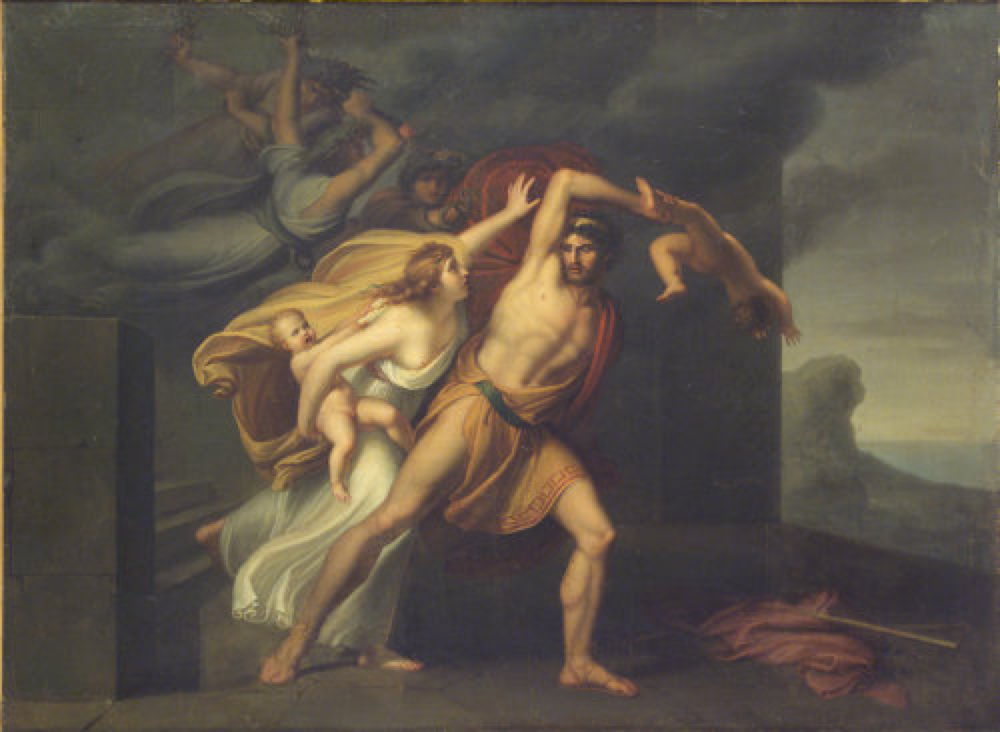Changing Paintings: 18 Ino and the fall of the house of Cadmus

With the tales of the daughters of Minyas completed, and the three of them transformed into bats, Ovid returns to complete his chronicle of the fall of the house of Cadmus. At this stage, Cadmus, the founder-king of Thebes, had five children:
Semele became pregnant by Jupiter and was then destroyed when he appeared in his full divinity to her; their son was the god Bacchus.
Polydorus, his only son, died young of an unknown cause.
Autonoë was among those who killed Pentheus; her own son Actaeon was killed by his hunting dogs after Diana transformed him into a stag.
Agave married Echion; their son Pentheus was killed by worshippers of Bacchus, including his mother and her sisters.
Ino married Athamas, and they are the victims of the next story.
Ovid leads into this with Ino’s family relationship with Bacchus, her own marriage to Athamas, and their two children. However, Juno isn’t happy with this, feeling that the family had still wronged her. She therefore seeks vengeance on Ino, intending her to suffer the madness that had led to the death of Pentheus.
Juno therefore enters Hades, passing its monstrous guardian Cerberus, and seeks out the Furies. The goddess sees some of those damned to impossible tasks, including Titys, Tantalus, Sisyphus, Ixion, and the Danaids, and wonders why they should suffer so, but Athamas should not, even though he has done nothing wrong.
Jan Brueghel the Elder (1568–1625), Juno in the Underworld (1596-98), oil on copper, 25.5 x 35.5 cm, Staatliche Kunstsammlungen Dresden, Dresden, Germany. Wikimedia Commons.
The only major work by a Master showing any part of this story is a real gem: Jan Brueghel the Elder’s Juno in the Underworld (1596-98). Brueghel’s vision of Hades rivals even Hieronymus Bosch’s apocalyptic scenes, and comes dangerously close to losing Juno altogether in its sea of horror and suffering.
Jan Brueghel the Elder (1568–1625), Juno in the Underworld (detail) (1596-98), oil on copper, 25.5 x 35.5 cm, Staatliche Kunstsammlungen Dresden, Dresden, Germany. Wikimedia Commons.
Juno’s cool blue robes and a couple of peacocks stand out from the reds and browns, the monsters and the tormented. She waves at the trio of Furies, with their snake-filled hair and screaming faces. A few years later, Wouters painted another version which could only have been based on this original.
Juno engages Tisiphone, one of the Furies, to bring Athamas down by driving him mad. Tisiphone readies her weapons, and visits Athamas in his palace. There she hurls two snakes from her hair at Athamas and Ino, and pours a poisonous concoction on them both.
Athamas is instantly driven mad, convinced that his wife is a lioness, and their sons her cubs. He snatches Learchus from his wife’s arms, and smashes the infant against hard rock. Ino, calling the name of Bacchus, flees to a high clifftop, still carrying their other infant son, Melicerta. Once there she launches herself towards the sea below.
Godfried Maes (1649–1700), Athamas Tearing his Children Apart (1664-1700), black chalk, pen and brown and grey ink, brown and grey wash, brown ink framing lines, some with watermarks, 18 x 24 cm, location not known. Wikimedia Commons.
Godfried Maes’ Athamas Tearing his Children Apart (1664-1700) is a fine chalk and pen drawing showing Athamas dashing the infant Learchus against the palace walls, and Ino, clutching Melicerta, heading rapidly towards the door in a bid to escape. To make his account even more explicit, he includes the figure of Tisiphone further up the staircase. I suspect this was destined to be engraved and used as a print, as a couple of other drawings of this story were.
The only two paintings that appear to have been made of this scene appeared in the same year; had they been French, I might have suspected that it had been the subject for the Prix de Rome that year, but both the painters were Italian, and I cannot find any reason for this strange coincidence.
Gaetano Gandolfi (1734-1802), Athamas Killing Ino’s Son (1801), oil on canvas, 92 x 63 cm, Villa Molinari Pradelli, Marano, Italy. Wikimedia Commons.
Gaetano Gandolfi’s Athamas Killing Ino’s Son (1801) shows Athamas wielding his infant son like a sledgehammer, and about to strike him against the ground with great force. Ino is holding Amathas’ hair, and the other son in her right arm. There’s no sign of any Fury.
Arcangelo Migliarini (1779-1865), Athamas after the Fury (1801), oil, dimensions not known, Accademia di San Luca, Rome. Wikimedia Commons.
Arcangelo Migliarini’s Athamas after the Fury (1801) composes the couple and their babies quite differently, although Learchus is about to suffer the same violent death. Behind them Tisiphone is still floating around, apparently bringing distress to others in Athamas’ palace. At the far right is the cliff to which Ino is about to run. In reality, Thebes isn’t that close to the sea, something also overlooked by Ovid.
At this moment, Venus intervenes, and gets Neptune to transform them both into gods: Ino into Leucothoë, the infant into Palaemon. They thus vanish from the earth, and Ino’s friends and household, who have been pursuing them, assume they are dead.
Juno has one final touch of pure spite: as those friends stand mourning the loss of Ino, the goddess turns them to stone, and transforms others to seabirds, probably albatrosses.
Ino’s transformation to a goddess is also a little confusing: Ovid has, through the daughters of Minyas, only just told of a Leucothoë who was turned into a frankincense tree, and the daughter of Minyas named Leuconoë. Ino was transformed into a sea goddess known as Leucothea, who appeared in the form of a gannet to Odysseus when he was shipwrecked, during the Odyssey.
Henry Fuseli (1741–1825), The Shipwreck of Odysseus (1803), oil on canvas, 175 × 139 cm, Private collection. Wikimedia Commons.
That appearance is shown in Henry Fuseli’s The Shipwreck of Odysseus from 1803, a highly dramatic account.
With the disposal of Athamas, Ino, and their children, the house of Cadmus, founder-king of Thebes, is finished. Ovid rounds it off with a short but touching myth that sees an end to the dynasty. It’s worth noting that, although Ovid names Cadmus’ wife as Harmonia, in other sources she’s known as Hermione.
Cadmus and his faithful wife Harmonia leave the city of Thebes, and travel until they eventually reach Illyria on the eastern side of the Adriatic Sea (roughly the former Yugoslavia), where they talk about earlier times. Cadmus wonders whether the fearsome dragon he had killed in order to found the city had in fact been sacred. He therefore calls on the gods to avenge its death, if that had been the case, and is transformed into a serpent.
Just before his upper body and head are changed, and with tears still streaming down his cheeks, he embraces his wife one last time. As his transformation completes, and Harmonia finds herself wrapped in his coils, she calls on the gods to transform her too, which they do.
Virgiliotto Calamelli (1531-1570), Cadmus and Harmonia (c 1560), Faenza maiolica ceramic, dimensions not known, Museo Internazionale delle Ceramiche, Faenza, Italy. Wikimedia Commons.
Virgiliotto Calamelli’s ceramic telling of Cadmus and Harmonia from around 1560 is a brilliant depiction of Ovid’s story. He chooses a later moment, in which Cadmus’ transformation is complete, and Harmonia’s has reached her abdomen.
Crispijn van de Passe the Elder (1589-1637), Cadmus and Harmonia Changed into Snakes (1602-07), engraving, 8.4 x 13.2 cm, Rijksmuseum, Amsterdam. Courtesy of The Rijksmuseum.
I’m not sure where Crispijn van de Passe the Elder sourced his engraving of Cadmus and Harmonia Changed into Snakes (1602-07), but it’s essentially the same as Calamelli’s plate. The town on the left is a bit more extensive, and the gods have been added in the clouds above, but even the intertwined coils of snake are a perfect match.
For over two centuries, this story vanished without trace from the visual arts, before being revived and revisualised by Evelyn De Morgan.
Evelyn De Morgan (1855–1919), Cadmus and Harmonia (1877), oil, dimensions not known, The De Morgan Collection, England. Wikimedia Commons.
Evelyn De Morgan’s Cadmus and Harmonia was painted in 1877, after she had returned from a visit to Italy. What inspired her to paint this unique work is obscure, but it was exhibited with the following quotation from an English translation of Metamorphoses:
With lambent tongue he kissed her patient face,
Crept in her bosom as his dwelling place
Entwined her neck, and shared the loved embrace.
It has been suggested that Harmonia is here reminiscent of Botticelli’s Venus, a painting De Morgan knew well, as she had copied it when a student. She certainly doesn’t seem to have been influenced by any earlier image of the story, but her Harmonia isn’t the older woman described by Ovid.
To the amazement of those around, the two snakes slither off into a nearby wood. Having been good people, they are neither venomous nor do they bite. So ends the house of Cadmus.
